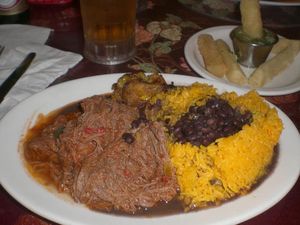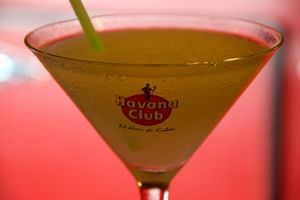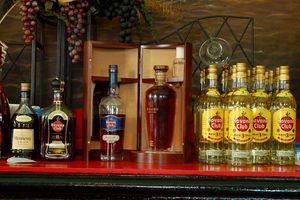

Cuban Cuisine
Learn more about Cuban cuisine, and what to eat and drink in Cuba.
We could say that the base for the Cuban cuisine is the Spanish one, since it provided an endless amount of ingredients and preparations; however, due to the difficulty of obtaining some of the typical Spanish ingredients in Cuba, criollos (mixed Spanish and Native peoples offspring) gradually introduced new elements creating a unique and marked cuisine unique to Cuba.
Cuban cuisine has also been deeply influenced by African culture, since enslaved people brought from Africa became, in some instances, cookers and kitchen staff.
Therefore, new ingredients such as the “ñame” (yam) and cooking methods were adopted.
Cuba also welcomed thousands of Chinese immigrants, which also contributed to the development of a syncretic cuisine.
In this case, the most important Chinese contribution was the “guinda” (cherry).
Some delicacies from the Cuban Cuisine are:
El Congrí: composed of “frijoles colorados” (red beans), pork meat, “chicharrones” (pork rinds), bacon, and rice.
Moros y Cristianos: stew of rice and black beans.
Lechon: the “lechón” is the young or baby pork. It is served roasted or fried.
Yuca con mojo: cooked yam with a sauce made of garlic, oil, salt, pepper, and lemon.
Ajiaco: this is a kind of “ragú de tasajo” (ragù) with salted meat, vegetables, corn, green plantains, potatoes, etc.
Langosta enchilada: a typical tourist dish made from lobster. Only foreigners eat this.
Tostones: smashed and fried pieces of green plantain.
Tasajo a la cubana: dried and stewed meat, served with plenty of sauce.
Tamal en cazuela con mariscos: a stew of “tamal” (tamale) and seafood that is pretty well spiced.
Ropa Vieja: veggies with meat.
Drinks in Cuba:
Cuba is the cocktail paradise: the renowned mojito, ron collins, daiquiris, piña colada, etc. are drank in a daily basis.
The king of alcoholic drinks here is rum, the national drink that has been granted international fame. The best known brand is Havana Club, but other good ones are Caribbean Club, Matusalén, Caney, Ron V.C., Varadero, Bucanero, Bocoy, and Paticruzado. Ron Santiago is also well known, especially the 15-year-old type, which can only be bought in Santiago de Cuba.
Rum and Fruit liqueurs are delicious, and not only used for drinking: in Cuba, they are used for fruit salads as well.
It’s important to note that alcohol grading in Cuba is different to the international standards. In small font, the European equivalent tends to be noted. For example, a 12º Cuban drink could be a 5.5º in Europe.
Cuba is also known for its excellent tropical fruit juices (or “jugos”). The Jugo de Caña, de Guarapo, and Agua de Coco are the most popular.
As for sodas, the most famous is Tropi-Cola, a kind of national Coke that is much sweeter.
Other common pops in the island are lemon and orange “Cachito” or Malta de Caracas, from Venezuela.
Cuban coffee is utterly thick and concentrated, and served in small quantities without sugar.
Why "Trip Cuba"?
Trip Cuba is an organization of Cuban agencies whose objectives are:
- ✓ To make Cuba, its culture and its heritage known.
- ✓ To promote sustainable tourism.
- ✓ To support the local economy, prioritizing direct contact with Cuban agencies.
Travel Agencies
If you are a travel agency or tour operator and you are looking forward to any assistance or collaboration to plan trips to Cuba, rely on our extensive experience
Copyright www.TripCuba.Org © - All rights reserved
All our agencies are duly registered in the National Registry of Travel Agencies of the Chamber of Commerce of the Republic of Cuba.









